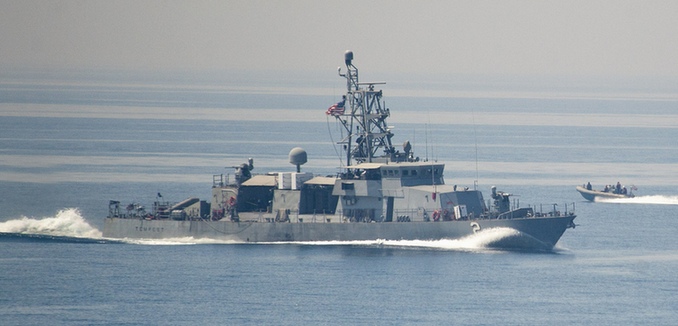A series of encounters between Iranian and American naval vessels in the Persian Gulf this month were marked by Iranian violations of “international law and maritime standards,” the U.S. Navy said on Wednesday.
New details have emerged about the incident in the southeastern part of the Persian Gulf near the Straits of Hormuz — a key international shipping route — where the destroyer USS Nitze was approached by four Iranian boats, two of which came within 300 yards. Both the Nitze and the USS Mason, a nearby U.S. destroyer, increased to high speed and moved away from the Iranian crafts, which were operated by the Islamic Revolutionary Guard Corps, Defense News reported on Thursday.
U.S. Navy Cmdr. Bill Urban, a spokesman for the Navy’s 5th Fleet, said that on August 15, seven IRGC vessels had fired rockets in “close proximity” to the two destroyers. “The Iranian vessels were within 12,000 yards of Nitze and 5,000 yards of Tempest,” he added. “The vessels were seen firing eight to nine rockets away from the US ships and did not notify them of the intent to conduct a live fire exercise.”
On Tuesday, two U.S. patrol coastal ships — USS Tempest and USS Squall — were operating in international waters in the northern part of the Gulf when IRGC naval boats approached them at a high speed and passed within 600 yards of Tempest three different times. The American crew attempted to alert the Iranian boats that their actions were dangerous and make radio contact.
Later that day, Tempest and Squall were harassed by a single Iranian Naser-class patrol boat, which is known to be operated by the IRGC. The vessel traveled toward Tempest head-on and came within 200 yards.
“This situation presented a drastically increased risk of collision,” Urban said, adding that “the Iranian vessel refused to safely maneuver in accordance with internationally recognized maritime rules of the road, despite several request and warnings via radio, and visual and audible warnings from both US ships.”
First, Tempest fired flares at the approaching boat and attempted to warn it using its loudspeaker system. Finally, Squall fired three warning shots from a .50 caliber gun, after which the Iranians changed course. The shots were fired away from the direction of all nearby vessels, including the Iranian boat, and no one was injured, Urban said.
The final incident took place on Wednesday, when the same Iranian Naser-class patrol boat came within “close range” of the destroyer USS Stout, which was patrolling in the northern gulf, and conducted what Urban described as an “unsafe intercept.” Because Stout can travel at much higher speeds than the IRGC boat, it maneuvered out of the way.
Urban said that the Navy’s Central Command “assessed all of these interactions as unsafe and unprofessional due to the Iranian vessels not abiding by international law and maritime standards, including the 1972 Convention on the International Regulations for Preventing Collisions at Sea (COLREGS) maritime ‘Rules of the Road.’”
“The Iranian high-rate-of-speed approaches towards three Unites States ships operating in international waters in accordance with international law along with multiple bow crossings at short range and the disregard of multiple warning attempts created a dangerous, harassing situation that could have led to further escalation,” he added.
According to U.S. officials, the incidents all involved the IRGC, which operates a navy in parallel to Iran’s regular naval force, and whose leaders answer directly to Iranian Supreme Leader Ayatollah Ali Khamenei, Defense News reported.
Ten American sailors and their two boats were seized by IRGC naval forces in January of this year in violation of international law.
Subsequent to the sailors’ release, Iran portrayed their capture as a victory against the U.S., releasing the sailors after claiming that Washington apologized for the incident. Khamenei proclaimed that the naval forces who captured the sailors did “God’s deed” and issued medals to the commanders involved, while the IRGC announced plans to build a statue to commemorate the seizure.
In May, the deputy commander of the IRGC threatened to close the strategic Straits of Hormuz to the U.S. and its allies if they “threaten us,” adding: “Americans cannot make safe any part of the world.”
The U.S. Navy reported last month that in 2015, there were close to 300 encounters or “interactions” between American and Iranian naval vessels in the Persian Gulf. While most of the encounters were not considered to be harassment, the behavior of the Iranian navy was found to be less disciplined than that of other navies. Lt. Forrest Griggs, the operations officer of the USS New Orleans, explained that risks arise from the unpredictable behavior and uncertain intent of the Iranian vessels. “It’s very common for them to come up to within 300, 500 yards of us, and then they’ll turn, or parallel us and stop,” he said.
Vice Adm. Kevin Donegan, the commander of the Navy’s 5th Fleet, observed in November that Iran’s “malign behavior” at sea had not changed since the announcement of the nuclear deal four months earlier.
[Photo: U.S. Naval Forces Central Command / Flickr ]




